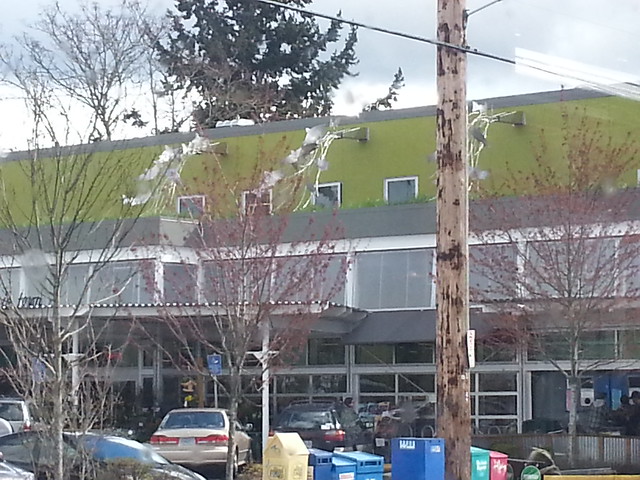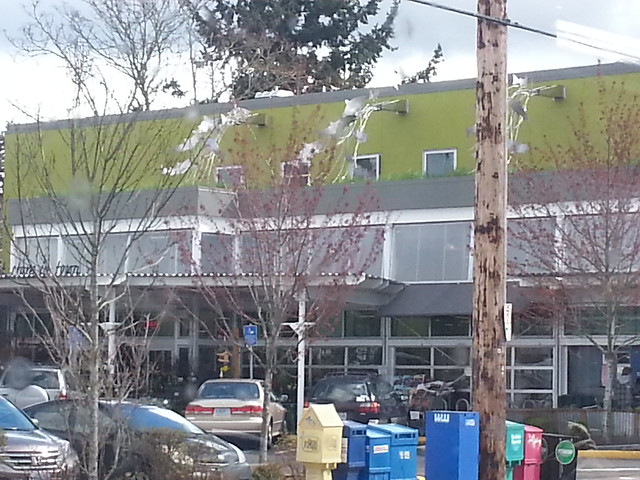So, a while back I ran into a list the city put together titled "Landscapes for Rain: The Art of Stormwater". Which is exactly what it sounds like: Art that does something with rain, or sends some sort of positive message about rain. Those of you who follow the TV show "Portlandia" will find nothing surprising or unusual about this. It's a little, I dunno, twee, if you ask me, but nobody ever asks me.
One item on the list leaped out at me: Flying Salmon isn't just part of this weird stormwater art genre; it's also yet another example of Heroic Salmon Swimming Upstream, an endlessly overused and abused motif around here that local public art buyers can't seem to get their fill of. Flying Salmon is not just any set of random downspouts, either; it's part of a swanky New Seasons grocery store in rapidly gentrifying North Portland, right along Interstate Avenue. The snark practically writes itself. Here's how the city describes it:
Flying Salmon, New Seasons Arbor Lodge -
Ivan McLean, Sculptor; Richard Brown Architects AIA;
Lango Hansen, Lanscape Architects; 2005
The highlight of the sustainable approach to rain water collection at this New Seasons Market is the rooftop garden above the entry vestibule. 6400 N Interstate Ave., Portland Oregon. More information on the architects at www.langohansen.com.
I actually took these photos from a southbound MAX train. I'd just been to the Oregon Slough Railroad Bridge, where I'd been rained on quite a bit, and I was cold, and didn't feel like it was worth getting off the train for another damn photo of salmon art. It would be hard to beat the top photo anyway; maybe in picture quality if I'd brought the DSLR along, but composition-wise... well, it's heroic salmon atop an upscale grocery store, and there's a freakin' Subaru parked out front. I couldn't beat that if I tried. Incidentally, last December was the 45th anniversary of Subaru arriving in Portland. Back in 1968, nobody could have guessed what a big deal Subaru would become here. Of course they probably figured we'd be flying atomic jetpacks around the moon colonies by now, but I digress.
It turns out that Flying Salmon was created by the same guy who did Rational Exuberance, a big bright yellow sculpture that temporarily sat outside the Pearl District's Encore condo tower. That title, of course, is a play on a famous phrase by Alan Greenspan about the overheated real estate market, and the sculpture sat outside the last condo tower built before the real estate bubble popped in 2008. I'm still not clear on how much of the irony here was intentional, and how much was a fortuitous accident. In any case, I rather liked the art itself, it was just the title I was all snarky about. And to be honest I don't actually dislike Flying Salmon either. I'm sure it's a great set of downspouts and that it's exactly what New Seasons wanted. It's just that it exists in a larger milieu of rich white hipster preciousness, and that's what I keep rolling my eyes about. I've been rolling my eyes about it for years, actually, and so far it doesn't seem to be helping.

